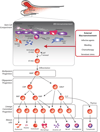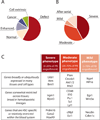Less is more: unveiling the functional core of hematopoietic stem cells through knockout mice
- PMID: 22958929
- PMCID: PMC3461270
- DOI: 10.1016/j.stem.2012.08.006
Less is more: unveiling the functional core of hematopoietic stem cells through knockout mice
Abstract
Hematopoietic stem cells (HSCs) represent one of the first recognized somatic stem cell types. As such, nearly 200 genes have been examined for roles in HSC function in knockout mice. In this review, we compile the majority of these reports to provide a broad overview of the functional modules revealed by these genetic analyses and highlight some key regulatory pathways involved, including cell cycle control, Tgf-β signaling, Pten/Akt signaling, Wnt signaling, and cytokine signaling. Finally, we propose recommendations for characterization of HSC function in knockout mice to facilitate cross-study comparisons that would generate a more cohesive picture of HSC biology.
Copyright © 2012 Elsevier Inc. All rights reserved.
Figures





References
-
- Adolfsson J, Borge OJ, Bryder D, Theilgaard-Monch K, Astrand-Grundstrom I, Sitnicka E, Sasaki Y, Jacobsen SE. Upregulation of Flt3 expression within the bone marrow Lin(-)Sca1(+)c-kit(+) stem cell compartment is accompanied by loss of self-renewal capacity. Immunity. 2001;15:659–669. - PubMed
-
- Arai F, Hirao A, Ohmura M, Sato H, Matsuoka S, Takubo K, Ito K, Koh GY, Suda T. Tie2/angiopoietin-1 signaling regulates hematopoietic stem cell quiescence in the bone marrow niche. Cell. 2004;118:149–161. - PubMed
-
- Benz C, Copley MR, Kent DG, Wohrer S, Cortes A, Aghaeepour N, Ma E, Mader H, Rowe K, Day C, et al. Hematopoietic stem cell subtypes expand differentially during development and display distinct lymphopoietic programs. Cell Stem Cell. 2012;10:273–283. - PubMed
Publication types
MeSH terms
Grants and funding
- CA125123/CA/NCI NIH HHS/United States
- R56 DK092883/DK/NIDDK NIH HHS/United States
- DK092883/DK/NIDDK NIH HHS/United States
- AI007495/AI/NIAID NIH HHS/United States
- K08 HL098898/HL/NHLBI NIH HHS/United States
- T32 AI007495/AI/NIAID NIH HHS/United States
- P30 CA125123/CA/NCI NIH HHS/United States
- R01 DK058192/DK/NIDDK NIH HHS/United States
- CA126752/CA/NCI NIH HHS/United States
- RC2 AG036562/AG/NIA NIH HHS/United States
- T32 GM008307/GM/NIGMS NIH HHS/United States
- T32 DK060445/DK/NIDDK NIH HHS/United States
- DK060445/DK/NIDDK NIH HHS/United States
- R01 DK092883/DK/NIDDK NIH HHS/United States
- T32 HL092332/HL/NHLBI NIH HHS/United States
- AG036562/AG/NIA NIH HHS/United States
- R21 AG034451/AG/NIA NIH HHS/United States
- P50 CA126752/CA/NCI NIH HHS/United States
LinkOut - more resources
Full Text Sources
Other Literature Sources
Medical
Molecular Biology Databases
Research Materials

